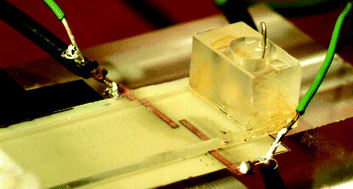Effects of the cell geometry and operating parameters on the performance of an external contactless conductivity detector for microchip electrophoresis
Abstract
Quantitative data on the effect of the electrode geometry on the signal strength and the signal-to-noise ratio is given. The measurements are affected by the unavoidable presence of stray capacitance. Best results are achieved for short and narrow electrodes arranged in an antiparallel configuration and separated by a minimal gap, which determines the dimensions of the actual detection volume. Limits of detection between 150 and 250 µg l−1 and separation efficiencies from 13 000 to 17 000 theoretical plates were achieved for six


 Please wait while we load your content...
Please wait while we load your content...